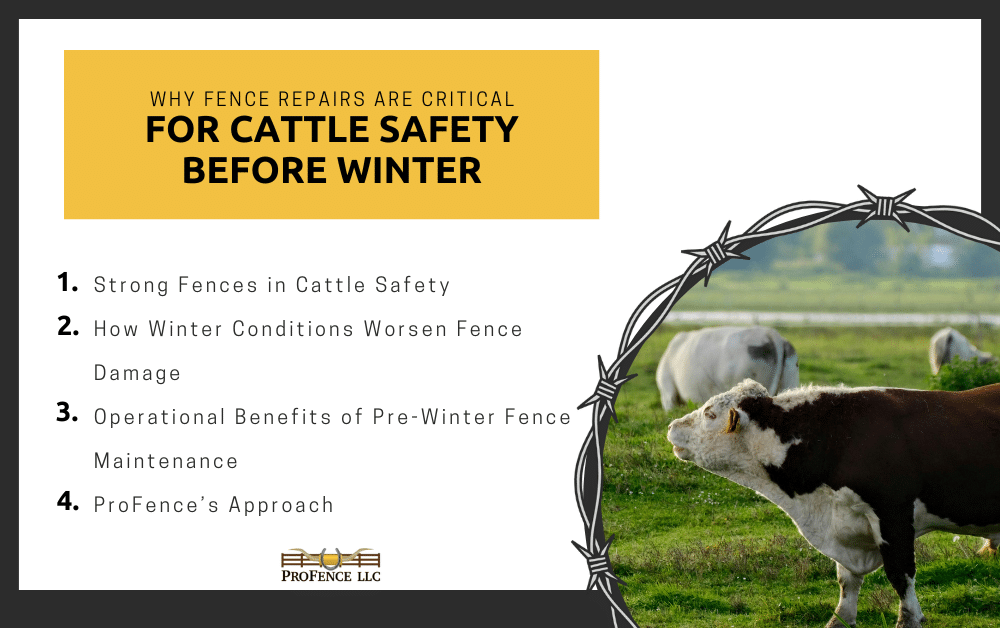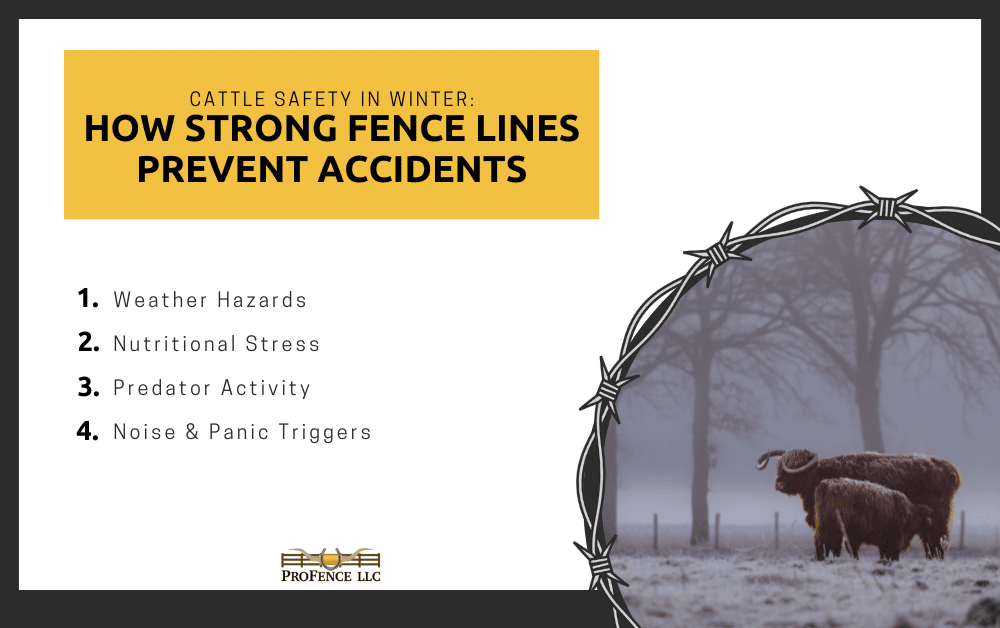As the temperatures drop and the days grow shorter, farmers begin their seasonal preparations for the long winter ahead. While many focus on stocking feed or preparing shelters, one of the most crucial steps for cattle safety is often overlooked: fence repairs before winter sets in. Strong, reliable fencing isn’t just a boundary line—it’s a lifeline that keeps cattle safe, secure, and healthy during the harshest months of the year.
Let’s explore why timely fence repairs are essential for protecting your herd and ensuring peace of mind throughout the winter season.
The Role of Strong Fences in Cattle Safety
Preventing Escapes and Winter Injuries
When pastures thin out in late fall, cattle naturally wander in search of fresh grass or feed. Weak or sagging fences make it easier for them to push through or climb over in their search for food. Once a breach occurs, an escaped cow in the middle of winter faces serious risks. Frostbite, injury from ice-covered terrain, or even collisions on nearby roads can all result from a momentary lapse in fence integrity. These situations also create financial stress for farmers who must repair property damage or replace lost livestock. Performing fence repairs before winter ensures safety, reduces liability, and keeps the herd where it belongs.
Protecting Against Predators During Harsh Weather
Predators such as coyotes, foxes, and stray dogs become more aggressive as food sources grow scarce during the colder months. A weak fence line offers them easy access to pastures and livestock, especially during calving season. Once predators learn they can breach a section, they’ll return again and again. Reinforcing fences and completing fence repairs before winter—tightening wire, replacing damaged boards, and closing gaps—creates a barrier that discourages intrusion. A well-maintained fence not only deters predators but also gives farmers peace of mind knowing their herd remains protected through long, dark nights.
Reducing Stress and Promoting Herd Stability
Cattle thrive on consistency and familiarity. When they know the boundaries of their grazing area, they remain calmer and easier to manage. Unstable or broken fences can cause agitation, leading animals to pace, escape, or fight among themselves. This behavior burns unnecessary energy and reduces weight gain during a time when nutrition is critical. Regular fence repairs and maintenance create a low-stress environment that promotes health and productivity throughout the winter months.
Supporting Safe Calving Environments
For farmers preparing for late-winter or early-spring calving, sturdy fences are crucial. They help separate expectant cows from the rest of the herd and keep vulnerable calves safe from predators or extreme conditions. A reliable fence system also helps maintain order during feeding and sheltering, minimizing the need to move cattle in freezing temperatures. Performing fence repairs and strengthening enclosures before winter ensures a smoother, safer birthing season for both mother and calf.
How Winter Conditions Worsen Fence Damage
The Freeze–Thaw Cycle and Material Stress
As temperatures fluctuate, moisture seeps into small cracks and openings in wooden posts, wire joints, or fasteners. When this moisture freezes, it expands, widening cracks and straining metal components. Over time, this cycle weakens the entire fence structure. Wooden posts split, nails loosen, and metal parts rust under repeated stress. By performing fall fence repairs—sealing cracks, replacing rotted posts, and tightening wire—farmers can stop this deterioration before it accelerates over winter.
Snow Load and Ice Pressure
Accumulated snow and ice can weigh heavily on fence lines, pulling wires downward and dislodging posts. Once that weight freezes in place, it becomes nearly impossible to fix without breaking the structure further. Preparing early by checking tension and completing necessary fence repairs prevents collapse under heavy loads. A properly maintained fence resists bending and sagging, saving time and labor when spring thaw arrives.
Ground Movement and Post Shifting
Winter’s freeze-thaw cycles don’t just affect the materials—they shift the soil itself. As ground moisture freezes, it expands, pushing posts upward or sideways. When it thaws, those posts may not settle evenly back into place, leaving gaps that weaken the fence. Compacting soil and performing fence repairs before winter prevents movement. Farmers who take this step will find their fences still standing tall and aligned when the snow melts.
Wildlife and Environmental Impact
Winter wildlife activity adds another layer of risk to fence stability. Deer and other large animals often press against fences while foraging, especially if vegetation is scarce. Fallen branches, drifting snow, and ice buildup can also damage lines over time. Conducting a thorough inspection and performing fence repairs before frost helps prevent winter wear. Strong fences can withstand both environmental pressure and animal contact without significant damage.
Operational Benefits of Pre-Winter Fence Maintenance
Maintaining Feed Efficiency and Pasture Control
Effective fence systems help farmers manage grazing patterns and preserve winter feeding areas. When cattle breach weak spots, they can overgraze or reach hay storage prematurely. That leads to wasted resources and nutritional imbalance during the months when feed costs are highest. Reinforcing fences and scheduling fence repairs ensures cattle remain where intended, preserving pasture quality and maintaining steady feed access.
Reducing Emergency Repairs and Labor Costs
Winter fence repairs are time-consuming, hazardous, and often require working in freezing temperatures. Snow, wind, and limited daylight make even small jobs difficult. By addressing maintenance issues before winter, farmers prevent emergencies that could cost double in materials and labor. Proactive fence repairs save time and reduce physical strain when conditions make outdoor work challenging.
Protecting Farm Equipment and Infrastructure
When fences fail, cattle can wander into areas where heavy equipment, fuel, or feed are stored. This increases the risk of property damage and injury. Loose or broken lines can also allow cattle to contaminate feed piles or trample stored hay. Regular fence repairs and inspections help maintain a secure barrier that keeps machinery, feed, and livestock safely separated, preventing costly accidents.
Improving Overall Herd Management
A well-maintained fence system simplifies movement and daily routines during the cold season. Farmers can easily rotate feeding zones, isolate sick animals, and direct cattle toward shelter without conflict or confusion. Routine fence repairs ensure these systems remain reliable. This organization saves time, reduces stress, and helps maintain a healthy herd through the toughest months of the year.
ProFence’s Approach to Reliable Winter-Ready Fencing
Identifying Weak Points Before They Fail
Subtle signs of wear often go unnoticed until they become major failures. ProFence’s inspection process identifies early indicators such as post rot, loose fasteners, and slack wire tension. By catching these weak points early, farmers can perform fence repairs before major breakdowns occur. A proactive inspection before winter ensures the entire system stays dependable even under snow and ice.
Using Durable, Weather-Resistant Materials
ProFence builds fences using materials designed to outlast harsh winters. High-tensile wire resists stretching, treated posts stand firm against rot, and reinforced bracing holds up under heavy snow loads. Each element is selected for long-term performance, reducing the need for frequent fence repairs. These weather-resistant materials create a fence that endures winter after winter with minimal upkeep.
Custom Solutions for Every Type of Farm
No two farms are identical—terrain, livestock type, and regional weather all impact fencing needs. ProFence tailors each solution to fit these unique challenges. Whether strengthening existing structures or installing new lines, they design fences that balance durability with efficiency. Their team considers slope, soil type, and animal behavior to ensure long-lasting protection that reduces the need for repeated fence repairs.
Why Professional Repairs Save Time and Money
DIY repairs may seem budget-friendly, but they often lead to uneven tension, weak joints, or misaligned posts. ProFence’s experienced crews use specialized tools and proven methods to ensure repairs meet agricultural standards. The result is a stronger, longer-lasting fence that minimizes future fence repairs and saves time and resources over multiple seasons. Professional service delivers peace of mind and better long-term value for farmers.
Secure Your Herd Before the Snow Falls
Fence repairs before winter aren’t just about appearances—they’re about safety, efficiency, and peace of mind. A sturdy fence protects cattle from predators, prevents costly escapes, and reduces stress all season long. Taking time now to walk your fence lines and make necessary fence repairs ensures fewer issues when conditions turn severe.
Contact ProFence today for a professional fence inspection or fence repairs before the first frost. Keep your herd safe, your property protected, and your fencing strong—no matter what winter brings.






